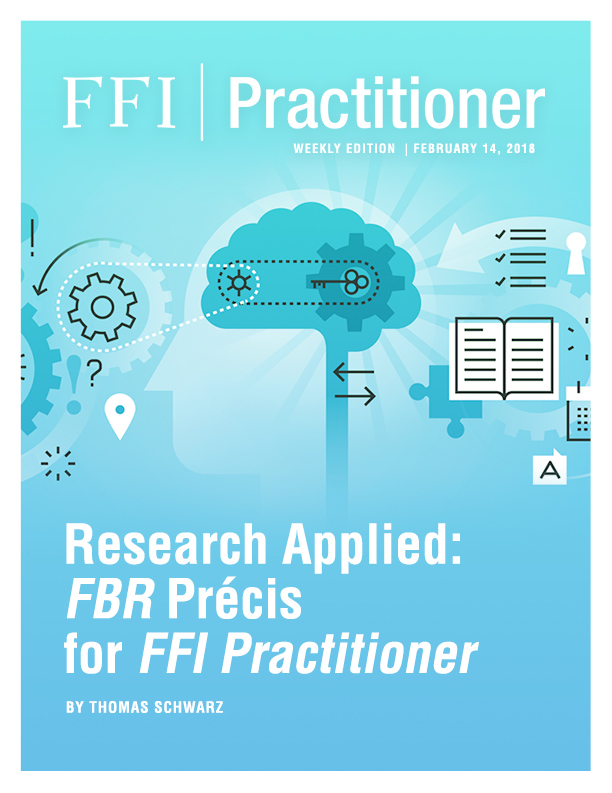Family Business Review
Research Applied: FBR Précis for FFI Practitioner
Weekly Edition • February 14, 2018


From FFI Practitioner
Thanks to Thomas Schwarz of the FBR Research Applied Board for his thoughtful précis of “Unpacking the Black Box of Family Business Advising: Insights From Psychology” – an article that appears in the March 2018 issue of FBR. This article and the related précis examine the authors’ conclusion that, despite tremendous recent efforts, we still know less about the field than desired, making family business advising more of an art than a science.
Introduction
This is an article about the giving and taking of advice. It is also about the difference between the ‘art’ and the ‘science’ of family business advising. Academic research, as in this article, is intended to discover and document the science of things; the ‘why’ and ‘how’ something works, in addition to the ‘what’ that has been found to work. To do so, researchers apply scientific methods that rely upon replicability, predictability, and causation. When these are widely unknown, the process is considered a ‘black box’ as in the title of this paper.

Sidebar

The internal structure and mechanisms of advice giving and taking remain a black box. Authors Vanessa Strike, Alexandra Michel, and Nadine Kammerlander introduce new concepts and variables from psychology that inform family firm advising, and identify important gaps to delineate avenues for future family firm research.
A major contribution of this study is that the authors rigorously review all that is known scientifically about family business advising. This is a heroic and valuable contribution. They conclude that while there have been tremendous increased efforts in the last decade, we still know far less than is desired, leaving family business advising primarily an art, or ‘black box’, somewhat akin to the wizard in the epic film, The Wizard of Oz. To help advance the field, the authors look to the four decades of advising research in the more established field of psychology, suggesting that we are left with far more unanswered questions than desired. (See their 9 key research gaps and 27 research questions in Table 7.) I recommend browsing through the columns that address the gaps and questions as a quick way of getting up to speed on what is not known, or what the ‘black box’ looks like now.)
In a way, this is good news for advisers. Every family business adviser has a method of engaging clients, assessing the issues, and then determining and delivering their advice. This is their art. While a set of best practices and instruments have developed over the years (e.g., family constitutions, governance guidelines, next generation leadership development programs), the article clearly identifies that there are important missing pieces. In many ways this is an article primarily calling upon and directing researchers over the next few decades.
Nonetheless, what does it reveal for practitioners today? Much I believe.
Findings
The authors initially review 194 family business and 220 psychology articles, followed by a more rigorous review of 88 total articles (52 from family business and 36 from psychology.) Subsequently, the authors introduce one of their main contributions of the paper which is to organize this large body of research within an Input-Process-Output (IPO) framework that helps identify progress and gaps.
Using this IPO perspective, the authors (in Tables 4 & 5, supplemented by the discussion under ‘Content Findings on Advising: An Input-Process-Output Perspective’) highlight the following for the two fields of existing research:
![]() Input variables: related to the attributes of the actors in the advising process (adviser, decision-maker, and relational aspects)
Input variables: related to the attributes of the actors in the advising process (adviser, decision-maker, and relational aspects)
- Adviser attributes in both fields have drawn complementary conclusions
- The importance of an adviser’s neutral role
- The importance of loyalty, commitment, qualifications, independence, objectivity, and sensitivity
- Decision-maker attributes (more often studied in psychology and rarely in family business)
- The emotions of the decision maker are important in advice taking
- Anger and pride decrease advice taking
- Shame and gratitude increase advice taking
- Similarity between the adviser and the decision-maker increases advice taking
- The emotions of the decision maker are important in advice taking
- Attributes of the decision/task and attributes of the advice
- Task difficulty or task importance affect a decision-maker’s willingness to follow advice
- Message features such as the politeness of communication, cost of advice, number of advising sources, and the distance of advice influence advice taking
In a way, the authors are acknowledging that the field of family business advising is primarily an art versus a science. The field of family business is so broad, with so many complexities and uniqueness, that there are rarely quick solutions or ‘one size fits all’ solutions.
![]() Process variables: As examples,
Process variables: As examples,
- Understanding advice giving processes
- How advisers capture and guide attention
- The frequency with which the adviser provides recommendations
- Advice taking and decision-making (primarily from the psychology field)
- What decision makers actually do with the advice received; the role of emotions
- The weight of advice (WOA); the extent to which the respondent follows advice
- Advice seeking
- Less likely when it is costly, when the decision-maker has experienced bad experience previously, or when adviser lacks soft skills
- Less likely when tasks are perceived as easy for fear of being perceived as incompetent
 Output variables:
Output variables:- Family firm studies: mainly focuses on the family and firm level mainly as economic or noneconomic consequences
- Psychology studies: mostly focus on individual level outcomes
- Research concerning the antecedents underlying whether the advice was followed or rejected
- Analysis of whether the advice was partly but not completely accepted
- Analysis of whether decisions were more accurate when advice was taken
- Examination of the effect on the decision maker, such as their level of confidence
Implications and Conclusions
The authors are motivated in their work by the lack of rigorous academic research on the family firm advising process. The research field still relies primarily on practitioner prescriptive. The authors call for more academic validation. They lay out a framework that provides clarity on what is known and where gaps remain. They look for contributions from the older discipline of psychology research. In a way, the authors are acknowledging that the field of family business advising is primarily and art versus a science. The field of family business is so broad, with so many complexities and uniqueness, that there are rarely quick solutions or ‘one size fits all’ solutions.
This paper is exhaustive. It covers decades of research from two fields intent on explaining human decision making. Consequently, it is complex and not an easy read. How could it be? The authors are to be commended for their heroic efforts and insights in making it somewhat easier of us all. The tables and figures are especially efficient in capturing a quick overview and some of the important detail elements. In the end, the authors have helped shine light on the pathway of where future research should be directed. In that regard, they have done us a great service in helping guide the future research findings we will continue to read in the upcoming years.
For The Practitioner:
- Be wary: there’s little scientific validation on what is often called “best practices.”
- Be helpful: contribute your knowledge and experience by being available for the qualitative studies that will inevitably emerge. Participate in quantitative studies as appropriate.
- Be diligent: although there’s not a lot of data out there, there is some and it’s an adviser’s responsibility to know as much as he or she can.
- Be a resource: work with researchers in your core discipline, from your alma mater, from universities in your area to help shape the research agenda that is being outlined in this article.
- Be challenging: you don’t have to believe everything you read – even if it comes from a well-known academic or research school. Promote the field and the knowledge base by engaging in the dialogue. In other words, “Write for FFI Practitioner” on these researched based articles.

About the contributor
Thomas V. Schwarz is an FFI Fellow, a former FFI board member, and one of the original editors of FFI Practitioner. He is a principal with Black Forest LLC and can be reached at Thomas@blackforestbusiness.com.
About the Précis
Each quarter, members of the FBR Research Applied Board write practice-oriented précis of articles appearing in a recent issue of Family Business Review (FBR) to be published in FFI Practitioner.

